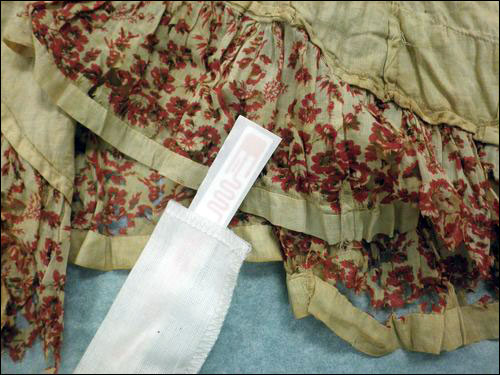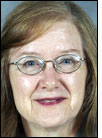Employees and volunteers at the University of Alabama‘s Carolyn Thomas Stewart Costume and Textile Collection are installing radio frequency identification technology to locate and track many of the collection’s 9,000 items, thereby providing better location data and ensuring that they do not need to repeatedly handle the often-delicate artifacts while performing inventory counts. The solution, provided by Silent Partner Technologies (SPT), located in Tarpon Springs, Fla., includes passive EPC Gen 2 ultrahigh-frequency (UHF) RFID tags sewn into the garments or items, as well as an RFID reader and encoder, a handheld interrogator for locating items within boxes and on shelves, and Silent Partner software for managing data about each object, linked to the ID number encoded to that item’s tag.
The collection’s curator, Virginia Wimberley—an assistant professor of clothing and textiles at UA—has installed the system thanks to funding from the Costume Society of America, a nonprofit organization that seeks to stimulate scholarship and encourage study in the field of historical clothing, as well as through private donations to the university.

The collection includes garments from the 19th century and later, as well as dolls and textiles that, in some cases, date back to the 15th century. Most are stored within boxes, in order to protect them from light, temperature changes and handling. These boxes are placed on shelves within a shared university storage area that is approximately the size of a football field. Other departments that utilize the site include paleontology and history, so among the items stored there are various types of butterflies, bones and historical artifacts. Periodically, staff members or volunteers must access objects from the Carolyn Thomas Stewart Costume and Textile Collection, either to be inventoried to ensure that they are still at the location where they are supposed to be, examined for research purposes, or put on display at the Alabama Museum of Natural History, located on the university’s campus. Those accessing the collection must open the boxes, locate a cotton twill label sewn onto each item and read that label’s printed number, indicating that object’s year of donation, donor and serial number. This requires manually handling the objects, some of which are very delicate. The printed serial number must then be interpreted and matched against a printed list of the items in the collection.
With RFID, Wimberley says, staff members or volunteers can identify a particular piece without having to open a box. An Alien Technology ALN-9627 H Wet Inlay RFID tag is being placed inside a muslin pouch, Wimberley explains, after which workers either sew the pouch into a garment’s hem or sleeve, attach it inside a hat, or affix it to any miscellaneous item in such a way that it will not damage the material of the item itself.
SPT provided an Ensyc Block RFID reader. Staff members place each tagged item onto the Block reader’s integrated antenna, and enter details about the object, such as its storage location, manufacturer, date obtained, value, make and model, as well as a photograph. All of this information is forwarded to the standalone Silent Partner Asset-Lite software, says Mark Noble, SPT’s sales manager, and is simultaneously linked to an ID number encoded to the tag. The garment or other item is then placed within its appropriate storage location.SPT also provided a Convergence Systems Ltd. (CLS) CS101 handheld reader, for use in interrogating tags on the stored items. Users have the option of utilizing the CS101’s Geiger counter functionality to search for a specific item, by entering that object’s ID number into the handheld and using the device’s touch screen to select the search function. They can also undertake an inventory process, by simply waving the handheld past every box on a rack and pressing an ID associated with that rack in order to indicate where each box was found. Upon returning to the office, they can plug the handheld into a computer’s USB port, where the data can be loaded into the SPT software. Staff members can then view where each item is located, and see a list of items considered missing. The SPT software is also loaded onto the handheld unit, so that users can view data and a picture of an item while reading the tag in the storage area.
The space in which the items are stored can be accessed from multiple departments, through one of eight doors. In the future, Wimberley says, she hopes to install a fixed reader at the door to her own office area, enabling the tracking of the day and time at which each item is removed from or returned to storage. If other departments choose to adopt similar RFID applications, fixed readers could be attached to every door, thereby providing full coverage of all egresses to that space.
The individuals who care for the garment and textile collection have finished sewing the tags’ pouches and are now attaching them to the items—typically by sewing them on manually. They will also continue sewing the standard twill tags onto new items for redundancy, Wimberley says, in the event of a problem involving an RFID tag.
Wimberley says she expects the system to save her and the staff many hours each month that would otherwise be spent searching for items, as well as ensuring a more accurate inventory record, while also protecting delicate items from being handled. “Sometimes, I can spend hours searching for one item that has been misplaced,” she explains, speculating that using an RFID reader would reduce the search time to mere minutes. In addition, the full inventory process—which, she says, currently “is pretty labor-intensive”—would be possible within a short period of time.
Wimberley hopes to have several thousand items tagged with RFID inlays by this summer. Tagging the remainder of the collection, she says, will require further funding.


